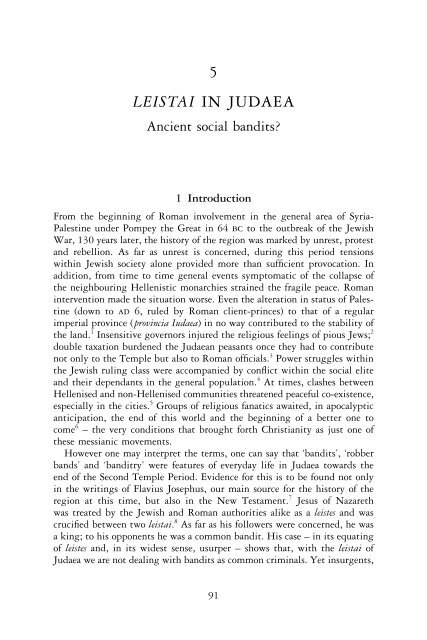You also want an ePaper? Increase the reach of your titles
YUMPU automatically turns print PDFs into web optimized ePapers that Google loves.
LEISTAI IN JUDAEA<br />
5<br />
LEISTAI IN JUDAEA<br />
Ancient social bandits?<br />
1 Introduction<br />
From the beginning of Roman involvement in the general area of Syria-<br />
Palestine under Pompey the Great in 64 bc to the outbreak of the Jewish<br />
War, 130 years later, the history of the region was marked by unrest, protest<br />
and rebellion. As far as unrest is concerned, during this period tensions<br />
within Jewish society alone provided more than sufficient provocation. In<br />
addition, from time to time general events symptomatic of the collapse of<br />
the neighbouring Hellenistic monarchies strained the fragile peace. Roman<br />
intervention made the situation worse. Even the alteration in status of Palestine<br />
(down to ad 6, ruled by Roman client-princes) to that of a regular<br />
imperial province (provincia Iudaea) in no way contributed to the stability of<br />
the land. 1 Insensitive governors injured the religious feelings of pious Jews; 2<br />
double taxation burdened the Judaean peasants once they had to contribute<br />
not only to the Temple but also to Roman officials. 3 Power struggles within<br />
the Jewish ruling class were accompanied by conflict within the social elite<br />
and their dependants in the general population. 4 At times, clashes between<br />
Hellenised and non-Hellenised communities threatened peaceful co-existence,<br />
especially in the cities. 5 Groups of religious fanatics awaited, in apocalyptic<br />
anticipation, the end of this world and the beginning of a better one to<br />
come6 – the very conditions that brought forth Christianity as just one of<br />
these messianic movements.<br />
However one may interpret the terms, one can say that ‘bandits’, ‘robber<br />
bands’ and ‘banditry’ were features of everyday life in Judaea towards the<br />
end of the Second Temple Period. Evidence for this is to be found not only<br />
in the writings of Flavius Josephus, our main source for the history of the<br />
region at this time, but also in the New Testament. 7 Jesus of Nazareth<br />
was treated by the Jewish and Roman authorities alike as a leistes and was<br />
crucified between two leistai. 8 As far as his followers were concerned, he was<br />
a king; to his opponents he was a common bandit. His case – in its equating<br />
of leistes and, in its widest sense, usurper – shows that, with the leistai of<br />
Judaea we are not dealing with bandits as common criminals. Yet insurgents,<br />
91


